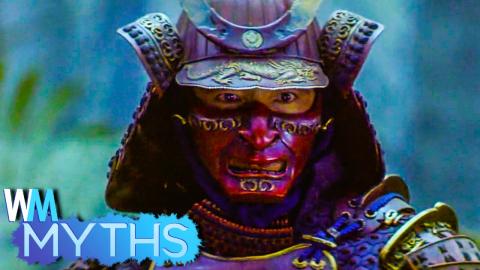Top 5 Myths About Samurai

Is a katana sharp enough to cut through BS? Welcome to WatchMojo's Top 5 Myths. In today's instalment we're counting down the Top 5 Myths About Samurai.
These legendary warriors have inspired countless works of fiction in pop culture. But sadly, such tributes have ultimately obscured the truth about these Japanese icons. Come along as we learn what truly lies under a samurai's mask. Spoiler… it's not Tom Cruise.
Special thanks to our user Ashjbow for submitting the idea on our interactive suggestion tool: WatchMojo.comsuggest/Top+5+Myths+about+Samurai
#5: Bushido Made Them "Good Guys"
Important warning for any would-be time travelers - just because a historical group had a code, doesn’t mean they necessarily followed it. Known as “Bushido”, this code by which Samurai led their lives roughly translates to “The way of the warrior”. It had many of the same admirable, yet lofty ambitions as the chivalric code, prioritizing justice, loyalty, duty, self-sacrifice, and so on. But the reality is, first and foremost, samurai were expected to carry out the instructions of their lord, and if that involved committing dishonorable acts, so be it. Ironically, samurai were also known to betray their lord for another if the pay proved better. They also had the right to kill any commoner they felt had not shown adequate respect.
#4: They All Led Warrior Lives
Alright, so you always idealized samurai as “virtuous warriors”, and we’ve slightly tainted the “virtuous” part. At least their legendary prowess on the battlefield is inarguable, right? Well, not so much. To be clear, the samurai were widely considered to be excellent warriors, but as we previously mentioned… samurai weren’t just a type of soldier, but rather an entire social class. They weren’t few and far between. In fact, they were many, at one point making up 10% of the country’s population. While it’s nice to imagine them as depicted on-screen, slicing through their enemies… many samurai living in peaceful periods were trained in the ways of the Samurai but led the life of scholars and bureaucrats.
#3: It Was A Male Only Class
Generally, when you think of samurai, you imagine men. But these warriors, also known as “bushi”, had a female equivalent, called onna-bugeisha, who served the same role as samurai in times of conflict. They were true warriors, expertly trained in art of combat. In place of the katana, which is archetypal weapon of samurai in popular media, onna-bugeisha typically wielded a “ko-naginata”. A long pole with a curved metal blade on its tip, this weapon afforded these female combatants excellent reach and versatility against their often-male enemies. Although they were nowhere near as common as their masculine counterparts, the exploits of the most famous among them, like Tomoe Gozen, were truly legendary.
#2: Seppuku Was Only About Honor
Also known as “hari kiri”, this form of ritual suicide, involving a short sword to the stomach, allowed a samurai to regain his honor after having been disgraced. Although romanticized on-screen, it wasn’t performed whenever a battle was lost. The truth is, samurai weren’t above retreating. When they did perform seppuku on the battlefield, it was usually as a last resort - a way to escape capture and torture at the hands of the enemy. For disgraced samurai sentenced to death, it was a practical matter… if they committed seppuku, their property would remain with their family. If they refused, it would be taken back by their lord. In some cases, it was even forcefully administered.
#1: The Katana Was Always Their Weapon Of Choice
Unfortunately, the legendary samurai sword is a veritable myth-magnet. Despite popular beliefs, a samurai could put his sword away without spilling blood, and generally speaking, could not effectively catch an enemy’s katana mid-swing. Nonetheless, a katana is the iconic weapon of a samurai, and with good reason. It was a crucial status symbol, exclusive to samurai. They also tended to be very expensive. But they didn’t use these blades as their exclusive weapon - samurai were adaptable. They used longbows called yumis, spears called yaris, and naginata. They also knew not to bring a katana to a gunfight. They began using a firearm known as the tanegashima, as well as cannons in the 16th century.